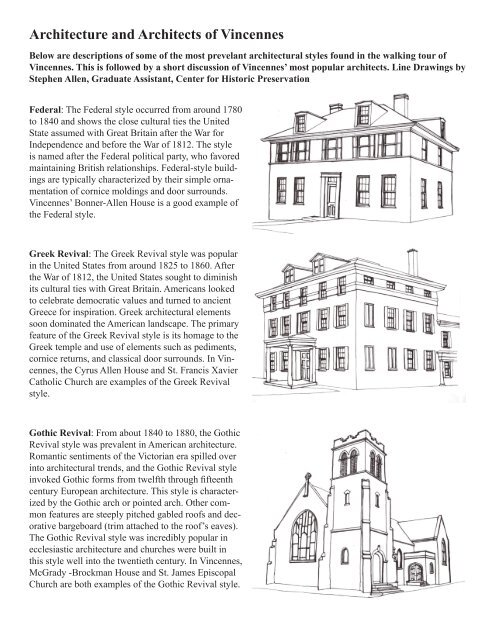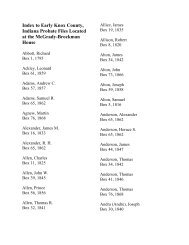Architecture and Architects of Vincennes - Knox County Public Library
Architecture and Architects of Vincennes - Knox County Public Library
Architecture and Architects of Vincennes - Knox County Public Library
Create successful ePaper yourself
Turn your PDF publications into a flip-book with our unique Google optimized e-Paper software.
<strong>Architecture</strong> <strong>and</strong> <strong>Architects</strong> <strong>of</strong> <strong>Vincennes</strong><br />
Below are descriptions <strong>of</strong> some <strong>of</strong> the most prevelant architectural styles found in the walking tour <strong>of</strong><br />
<strong>Vincennes</strong>. This is followed by a short discussion <strong>of</strong> <strong>Vincennes</strong>’ most popular architects. Line Drawings by<br />
Stephen Allen, Graduate Assistant, Center for Historic Preservation<br />
Federal: The Federal style occurred from around 1780<br />
to 1840 <strong>and</strong> shows the close cultural ties the United<br />
State assumed with Great Britain after the War for<br />
Independence <strong>and</strong> before the War <strong>of</strong> 1812. The style<br />
is named after the Federal political party, who favored<br />
maintaining British relationships. Federal-style buildings<br />
are typically characterized by their simple ornamentation<br />
<strong>of</strong> cornice moldings <strong>and</strong> door surrounds.<br />
<strong>Vincennes</strong>’ Bonner-Allen House is a good example <strong>of</strong><br />
the Federal style.<br />
Greek Revival: The Greek Revival style was popular<br />
in the United States from around 1825 to 1860. After<br />
the War <strong>of</strong> 1812, the United States sought to diminish<br />
its cultural ties with Great Britain. Americans looked<br />
to celebrate democratic values <strong>and</strong> turned to ancient<br />
Greece for inspiration. Greek architectural elements<br />
soon dominated the American l<strong>and</strong>scape. The primary<br />
feature <strong>of</strong> the Greek Revival style is its homage to the<br />
Greek temple <strong>and</strong> use <strong>of</strong> elements such as pediments,<br />
cornice returns, <strong>and</strong> classical door surrounds. In <strong>Vincennes</strong>,<br />
the Cyrus Allen House <strong>and</strong> St. Francis Xavier<br />
Catholic Church are examples <strong>of</strong> the Greek Revival<br />
style.<br />
Gothic Revival: From about 1840 to 1880, the Gothic<br />
Revival style was prevalent in American architecture.<br />
Romantic sentiments <strong>of</strong> the Victorian era spilled over<br />
into architectural trends, <strong>and</strong> the Gothic Revival style<br />
invoked Gothic forms from twelfth through fifteenth<br />
century European architecture. This style is characterized<br />
by the Gothic arch or pointed arch. Other common<br />
features are steeply pitched gabled ro<strong>of</strong>s <strong>and</strong> decorative<br />
bargeboard (trim attached to the ro<strong>of</strong>’s eaves).<br />
The Gothic Revival style was incredibly popular in<br />
ecclesiastic architecture <strong>and</strong> churches were built in<br />
this style well into the twentieth century. In <strong>Vincennes</strong>,<br />
McGrady -Brockman House <strong>and</strong> St. James Episcopal<br />
Church are both examples <strong>of</strong> the Gothic Revival style.
Italianate: The Italianate style <strong>of</strong> architecture was<br />
incredibly popular in Indiana from approximately<br />
1840 to 1885. The Italianate style was featured on<br />
both residential <strong>and</strong> commercial buildings. The style is<br />
loosely based on romantic notions <strong>of</strong> the Italian villa<br />
<strong>and</strong> Renaissance Italy. Features common to the Italianate<br />
style include ornate brackets along the ro<strong>of</strong>line <strong>and</strong><br />
tall <strong>and</strong> narrow windows with rounded arches. The<br />
Heberd Building, Moore <strong>and</strong> Harris Drug Store, <strong>and</strong><br />
St. Francis Xavier School are all excellent specimens<br />
<strong>of</strong> the Italianate style.<br />
Romanesque Revival: Inspired by European architecture<br />
from the tenth through thirteenth centuries<br />
that highlighted ancient Roman architecture, the<br />
Romanesque Revival style appeared in the American<br />
built environment from around 1880 to 1900. This<br />
style appeared on houses, commercial buildings,<br />
churches, <strong>and</strong> civic buildings like courthouses. The<br />
style is most easily identified by its prolific use <strong>of</strong><br />
rounded arches constructed <strong>of</strong> heavy masonry. The<br />
First Presbyterian Church is a typical example <strong>of</strong> the<br />
Romanesque Revival style.<br />
Neoclassical: The Neoclassical style resurrected<br />
classical Greek elements <strong>and</strong> design on a scale much<br />
larger than the earlier Greek Revival style. Neoclassical<br />
buildings were typically commercial or civic structures,<br />
though it did occur occasionally in residential<br />
construction. Neoclassical style architecture typically<br />
boasted the use <strong>of</strong> columned porticos, pediments, <strong>and</strong><br />
pilasters. There are many examples <strong>of</strong> the Neoclassical<br />
style in <strong>Vincennes</strong>, such as the First Baptist Church,<br />
Second National Bank, <strong>and</strong> <strong>Vincennes</strong> Post Office.
Italian Renaissance Revival: A second wave <strong>of</strong> interest<br />
in Italian Renaissance architecture began in the late<br />
nineteenth century <strong>and</strong> grew popular during the early<br />
twentieth century (c.1890 to c.1935). This second style<br />
wave, knows as the Italian Renaissance Revival style,<br />
tried to more accurately represent historical Italian architecture.<br />
After WWI, this style exploded with popularity,<br />
as soldiers who returned home hoped to recreate<br />
the picturesque architecture they witnessed in Europe.<br />
The Italian Renaissance Revival style is best displayed<br />
on the Fortnightly Club <strong>and</strong> Pantheon Theatre.<br />
Mission Revival: The Mission Revival style was<br />
popular from 1890 to 1820, but it reached its peak<br />
from 1915 to 1925. This style originated in the American<br />
southwest <strong>and</strong> is modeled after Spanish colonial<br />
mission buildings. The Mission Revival style is<br />
characterized by shaped parapets, stucco cladding, <strong>and</strong><br />
tiled ro<strong>of</strong>s. The Gould House/Knights <strong>of</strong> Columbus<br />
Building is a superb <strong>and</strong> rare example <strong>of</strong> the Mission<br />
Revival style.<br />
Collegiate Gothic: A variance <strong>of</strong> the popular Tudor<br />
Revival style, another turn-<strong>of</strong>-the-twentieth century<br />
period revival style, is the Collegiate Gothic style.<br />
The Tudor Revival style is based loosely on medieval<br />
English buildings <strong>and</strong> the Collegiate Gothic style is<br />
characterized by its use <strong>of</strong> the Tudor arch, or flattened<br />
arch. As the name implies, the Collegiate Gothic style<br />
was largely used on educational buildings. The <strong>Knox</strong><br />
<strong>County</strong> <strong>Public</strong> <strong>Library</strong> <strong>and</strong> <strong>Vincennes</strong> Coliseum display<br />
the Collegiate Gothic style.<br />
Art Deco: The Art Deco style was popular between<br />
WWI <strong>and</strong> WWII. The style was characterized by stylized<br />
<strong>and</strong> modern design, based on the French decorative<br />
arts. The style also emphasized verticality <strong>and</strong><br />
used angular geometric designs as ornamentation. The<br />
style mostly occurred on commercial <strong>and</strong> civic buildings<br />
<strong>and</strong> rarely on residences. The New Moon Theatre<br />
exemplifies the Art Deco style.
<strong>Vincennes</strong> <strong>Architects</strong>:<br />
By the turn <strong>of</strong> the twentieth century, <strong>Vincennes</strong> was home to several talented architects <strong>and</strong> you will see many<br />
examples <strong>of</strong> their work along this tour. John W. Gaddis was the first <strong>of</strong> these noted architects to establish a firm<br />
in <strong>Vincennes</strong>. He began working here in 1883 <strong>and</strong> his impressive career spanned into the twentieth century. He<br />
designed the American National Bank, <strong>and</strong> the George Rogers Clark Junior High, which you will see later. He<br />
also designed several Indiana county courthouses, including ones in Clay, Huntington, <strong>and</strong> Putnam counties.<br />
John Gaddis died in 1931.<br />
In the 1890s Thomas Campbell established himself as an architect in <strong>Vincennes</strong>. Campbell was born in Irel<strong>and</strong><br />
<strong>and</strong> moved to the United States as a boy <strong>and</strong> was a carpenter by trade. He was likely a self-taught architect<br />
<strong>and</strong> designed many elegant building here, including the J. T. Oliphant Building <strong>and</strong> the Second National Bank.<br />
Campbell partnered with Louis Osterhage from 1907 to 1913. Osterhage was another prominent local architect,<br />
who worked until his death in 1923. Campbell retired in 1913 <strong>and</strong> died in 1928.<br />
One <strong>of</strong> the most prolific architects in <strong>Vincennes</strong> was native son John B. Bayard. Bayard was a veteran <strong>of</strong> the<br />
Spanish American War <strong>and</strong> he began working in <strong>Vincennes</strong> sometime afterward. Bayard completed designs<br />
for many <strong>of</strong> the buildings you will see, including the First National Bank <strong>and</strong> the <strong>Vincennes</strong> Post Office. Sadly,<br />
Bayard took his own life in 1933 at the age <strong>of</strong> fifty-six after experiencing declining health.<br />
Finally, Lester W. Routt was another popular <strong>Vincennes</strong> architect. Routt was born in Washington, Indiana, in<br />
1891 <strong>and</strong> served in WWI. Before the war he worked for the <strong>Vincennes</strong> architectural firm <strong>of</strong> Campbell <strong>and</strong> Osterhage<br />
<strong>and</strong> he returned to the firm after the war. In 1923 he partnered with another <strong>Vincennes</strong> architect, Byron<br />
Sutton, but he eventually opened a solo firm in 1939. Routt’s career lasted for several more decades <strong>and</strong> he died<br />
in 1970.










